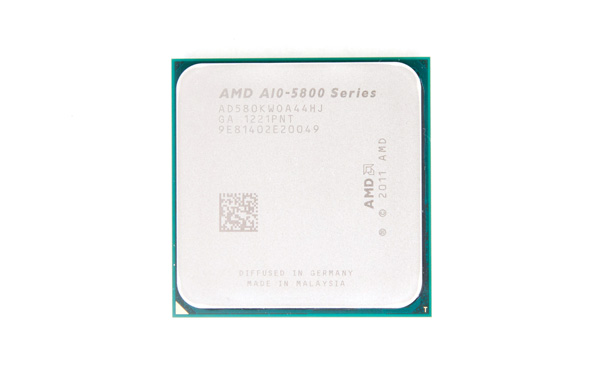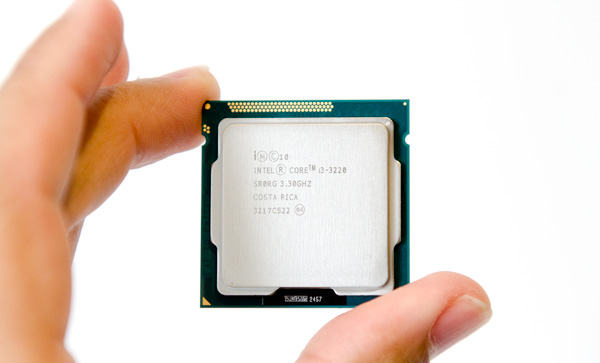AMD A10-5800K & A8-5600K Review: Trinity on the Desktop, Part 2
by Anand Lal Shimpi on October 2, 2012 1:45 AM ESTAlthough AMD's second-generation mainstream APU platform, codename Trinity, launched months ago in notebooks the official desktop launch is today. Rumor has it that AMD purposefully delayed the desktop Trinity launch to clear out unsold Llano inventories in the channel. Although selling APUs in notebooks is pretty easy, convincing desktop users to forgo the discrete GPU option (and ignore Intel) has been a tough battle for AMD. I keep going back to two slides that show us where AMD wants to go and the cores it'll take to get there:

The ultimate goal is this beautiful cohesive operation between CPU and GPU on a single die. That future will require a lot of software support, not only at the application level but also at the OS level. And I'm not talking about Windows 8. We're still far away from this APU dominated future, but AMD is marching in that direction. The second slide shows the x86 cores that we'll see from AMD along the way. AMD is still playing catch-up in the x86 CPU space and it's got a lot of lost time to make up for. There's no hiding the fact this is going to be a multi-year effort to simply get close to Intel's single-threaded x86 performance. Through pricing, leveraging its GPU technology and throwing more transistors at the problem AMD can still deliver competitive solutions, but it's not going to be a walk in the park.
Last week we took a look at the GPU side of the desktop Trinity APUs. We looked at the top end 384-core Radeon HD 7660D configuration as well as the slightly slower 256-core Radeon HD 7560D GPU, both of which easily outperformed Intel's HD 4000 and HD 2500. As far as processor graphics go, Trinity on the desktop maintains a healthy lead over Intel. There's still a place for discrete GPUs but that's pretty much at the $100 and above price points.
Today we're able to talk about pricing and x86 CPU performance among other things. The good news on that front is the most expensive Trinity APU is fully unlocked and is priced at $122:
| AMD Socket-FM2 Lineup | ||||||||
| Modules/Cores | CPU Clock Base/Turbo | L2 Cache | GPU | TDP | Price | |||
| A10-5800K | 2 / 4 | 3.8 / 4.2 GHz | 4MB | 384 cores @ 800MHz | 100W | $122 | ||
| A10-5700 | 2 / 4 | 3.4 / 4.0 GHz | 4MB | 384 cores @ 760MHz | 65W | $122 | ||
| A8-5600K | 2 / 4 | 3.6 / 3.9 GHz | 4MB | 256 cores @ 760MHz | 100W | $101 | ||
| A8-5500 | 2 / 4 | 3.2 / 3.7 GHz | 4MB | 256 cores @ 760MHz | 65W | $101 | ||
| A6-5400K | 1 / 2 | 3.6 / 3.8 GHz | 1MB | 192 cores @ 760MHz | 65W | $67 | ||
| A4-5300 | 1 / 2 | 3.4 / 3.6 GHz | 1MB | 128 cores @ 724MHz | 65W | $53 | ||
| Athlon X4 750K | 2 / 4 | 3.4 / 4.0 GHz | 4MB | N/A | 100W | $81 | ||
| Athlon X4 740 | 2 / 4 | 3.2 / 3.7 GHz | 4MB | N/A | 65W | $71 | ||
Compare this to Llano's launch where the top end SKU launched at $135 and you'll see that AMD is somewhat getting with the times. I would still like to see something closer to $100 for the A10-5800K, but I find that I'm usually asking for a better deal than what most CPU makers are willing to give me.
AMD's competitive target is Intel's newly released Ivy Bridge Core i3 processors. There are only five Core i3s on the market today, four of which use Intel's HD 2500 graphics. The cheapest of the lineup is the Core i3 3220 with two cores running at 3.3GHz for $125. Intel disables turbo and other features (there's effectively no overclocking on these parts), which AMD is attempting to exploit by pitting its Trinity K-series SKUs (fully unlocked) against them. AMD's TDPs are noticeably higher (100W for the higher end K-series parts compared to 55W for the Core i3s). Intel will easily maintain the power advantage as a result under both CPU and GPU load, although AMD's GPU does deliver more performance per watt. Power consumption is a major concern of AMD's at this point. Without a new process node to move to for a while, AMD is hoping to rely on some design tricks to improve things in the future.
At the low end of the stack there are also two Athlon X4s without any active GPU if you just want a traditional Trinity CPU.
The Test
This will be our last CPU/APU review on the current test platform/software configuration. The next major CPU review will see a move to a brand new testbed running Windows 8. As always you can get access to far more numbers than what we report here if you use our performance comparison engine: Bench. Of course if you want to see the GPU and GPU Compute performance of AMD's Trinity APU check out part one of our coverage.
| Motherboard: |
ASUS P8Z68-V Pro (Intel Z68) ASUS Crosshair V Formula (AMD 990FX) Gigabyte GA-F2A85X-UP4 (AMD A85X) Intel DZ77GA-70K (Intel Z77) |
| Hard Disk: |
Intel X25-M SSD (80GB) Crucial RealSSD C300 OCZ Agility 3 (240GB) |
| Memory: | 2 x 4GB G.Skill Ripjaws X DDR3-1600 9-9-9-20 |
| Video Card: |
ATI Radeon HD 5870 (Windows 7) AMD Processor Graphics Intel Processor Graphics |
| Video Drivers: | AMD Catalyst 12.8 |
| Desktop Resolution: | 1920 x 1200 |
| OS: | Windows 7 x64 |













178 Comments
View All Comments
ditroia - Tuesday, October 2, 2012 - link
Hi Does anyone know what the highest end Radeon GPU I can use to Crossfire with the 7 Series GPU on the APU?Thanks in Advance
Dave
Roland00Address - Tuesday, October 2, 2012 - link
Cards you can do crossfire with the integrated graphics are as followsIf you buy itself
6450, 6570, 6670
If you get it prebuilt (these are the same gpus as above but they have a 1000 added to the number for that is what hp, dell, acer convinced amd to do for bigger numbers sell).
7450, 7570, 7670
That said you might want to do your research on asymmetric crossfire before hand, based on other websites reviews that tested it you are only going to get 30 to 60 percent scaling and the 7700 series cards are usually faster than the asymmetric crossfire.
ditroia - Tuesday, October 2, 2012 - link
Disappointing that you can't crossfire with a & series Discrete 7 series GPU, as I think that would have made a cheap but powerful Gaming system.Thanks
mikato - Wednesday, October 3, 2012 - link
Yeah I was really hoping to see a Crossfire with a lower end card as part of this review.Jamahl - Tuesday, October 2, 2012 - link
Llano vs the 2105 last year -http://www.anandtech.com/show/4476/amd-a83850-revi...
"Look at our single-threaded Cinebench scores below and you'll see a 50% performance advantage."
"CPU bound gaming performance is also an area where the A8 falls behind the i3. Here you're looking at a 25 - 50% advantage for the i3-2100/2105"
This is partly due to Ivy Bridge being so underwhelming.
The only problem I see is with load power which has gone backwards.
JKnows - Tuesday, October 2, 2012 - link
Video Drivers: AMD Catalyst 12.3 ???Are you kidding? That driver cannot even use Trinity architecture...
aislanluiz - Tuesday, October 2, 2012 - link
We’re power users, after all. We know how to cope with heat and noise; we can deal with a 100 W chip, even in an HTPC. But there’s no way to make the Core i3 look better unless you spring for an add-in card. AMD’s emphasis on balance makes the A10-5800K a better platform for more people than Intel’s closest competition.frozentundra123456 - Tuesday, October 2, 2012 - link
Trinity may be attractive for HTPC, but I cannot imagine a "power user" who does not have a discrete card in a desktop, at least if you are at all into gaming. The igpus are pathetic for gaming and you get better performance with intel plus discrete card.ericore - Tuesday, October 2, 2012 - link
I don't think Anand has a single benchmark that uses an App from AMD appStore. Even Tom's hardware was considerate enough to use Adobe CS6 products. I'm sorry but this benchmark makes Intel look better than it does. The benchmark is fully Intel optimized, System Max is Intel Optimized, no a single benchmark is AMD optimized. Disappointed Anand.The following review is much more fair:
http://www.tomshardware.com/reviews/a10-5800k-a8-5...
Beenthere - Tuesday, October 2, 2012 - link
The haters won't be happy but it's great that AMD has delivered as promised with Trinity desktop in addition to laptop. Trinity desktop delivers performance and value for those looking for an all-in-one solution at an extremely affordable price - which is a growing segment of the market as people discover the huge cost savings compared to a discrete CPU/GPU set-up. BTW, no one would ever consider Intel 2500 graphics as being usable, so the Trinity desktop APUs are literally in a class of their own for now.It's also worth noting that single thread performance is not the holy grail. Most people running modern software will be perfectly happy with Trinity desktop performance even if you crunch numbers now and then. Price and performance wise AMD has delivered a winning solution when you look at performance vs. cost. This will force Intel to discount it's i3/i5 products, which is good for all.
Obviously Trinity desktop is NOT intended as a replacement for a highend discrete CPU/GPU system. That will come in a few more years but for now AMD continues to offer excellent performance and value, which is what mainstream consumers desire.